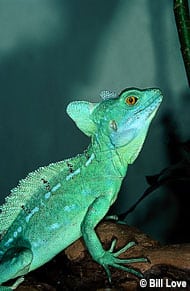Description:
The green basilisk or plumed basilisk is among the showiest herps on Earth. No wonder it’s a favorite as a captive! These brilliant green beauties make interesting captives, but require more effort to please in a cage than many other lizards. Give the green basilisk a large cage that’s tall so they can climb on stout branches. First off, insist upon acquiring a captive-born green basilisk because wild-caught imports are nervous and flighty creatures that rarely settle down to be satisfactory pets. Get one under 12 inches long whenever possible so it will acclimate well and learn not to be afraid of its keeper. Green basilisks are primarily carnivores that gobble up almost any animal smaller than themselves. In captivity, insects (for juveniles) and mice make up the bulk of the diet. Offer live, moving food items late in the morning after the green basilisk has had time to bask and warm up to hunting temperature. Green basilisks come from steamy forests where it’s never extremely dry. Mist their cage often to maintain a high level of humidity, yet assure adequate ventilation so the air and cage never stays wet and mold starts to grow. Also install a small water bowl for drinking water.
Habitat:
Lush foliage along waterways
Range:
Lower Central America
Scientific Name: Basiliscus plumifrons
Species Group: basilisk
Family: Iguanidae
Size: 18 to 27 inches in total length, most of which is tail
Level: intermediate
Weight:
Dangerous: No



